Spring Green, Wisconsin
Pages 2, 10
Celebrate spring’s arrival at Frank’s Hill
Winter has not yet relinquished the season’s cold grip on the landscape but the calendar says spring will arrive soon. The tradition of observing solstice and equinox events at a site in southern Richland County will continue with recognition of the vernal equinox amongst the ancient effigy mounds at Frank’s Hill near Muscoda.
The Three Eagles Foundation will welcome people for the sunset on March 20, and sunrise on March 21, marking of the official

Editorial: Partisan budget rhetoric is tired
Page 3
changing of the seasons. The east-west alignment of the mounds coincides with the due east-west alignment of the sunrise and sunset at the spring equinox. Spring begins at 4:24 p.m. on March 20, meaning the first sunset of spring will be that evening and the first sunrise of spring will be Tuesday morning. Representatives of the Foundation will be on Hill East for both events, weather permitting. Frank’s Hill will be open to the public for self-guided tours the weekend
Page 8
of March 18 & 19. A short hike to the top of the hill that offers a stunning view of the lower Wisconsin River valley will be required. Guests should arrive by 6:30 a.m. for sunrise or 6:30 p.m. or earlier to observe the sunset. The site is located 2 miles west of Muscoda near the intersection of Hwy. 60 & Hwy. 193. Park well off the road on the shoulder and enter by the gate.

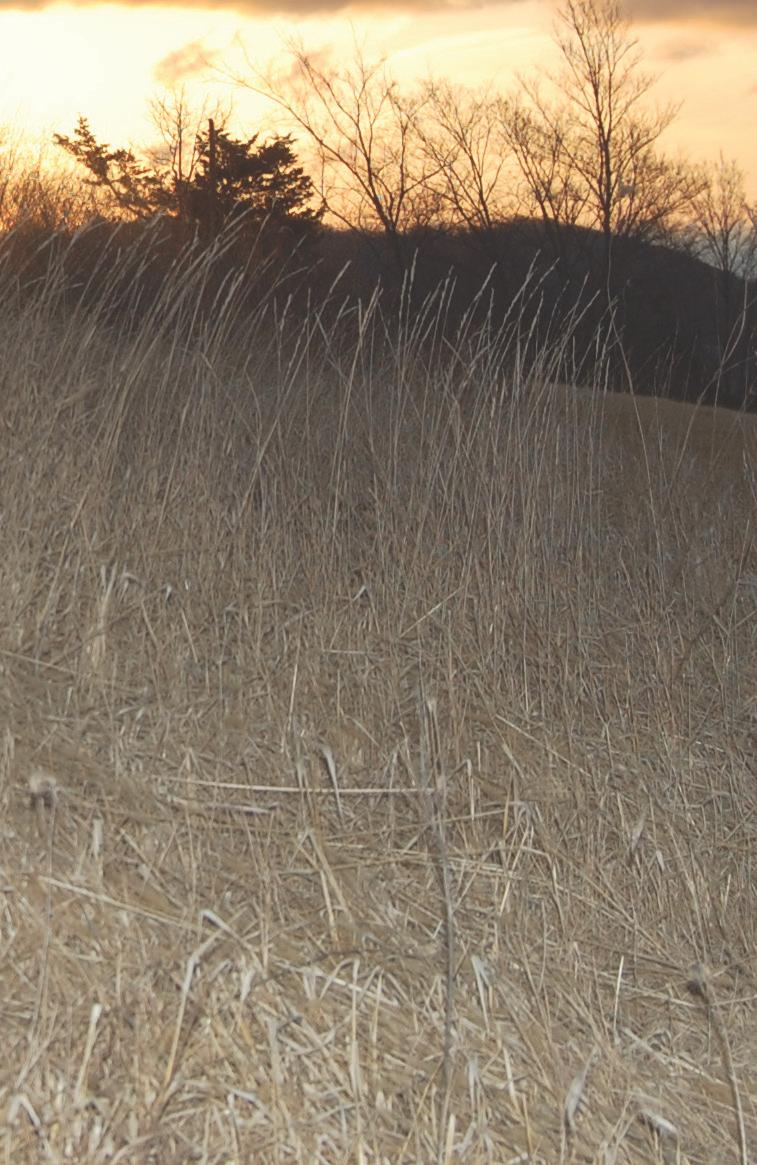

Frank’s Hill is on the National Register of Historic Places. A group of unique effigy
River Valley School District Endowment celebrates milestone, announces Legacy Society
Jennifer Kraemer, River Valley School District Endowment
RVMS Blackhawk Outdoor Sculpture
– K/3 STEM Educational Enrichment
– RV Broadcast Studio – Heart Zone
Technology – Saving Nemo – School
Compost Tumbler – Choose Kind
Initiative — These 7 project titles, plus 33 others listed on the RVSD website at www.rvschools.org/community/ rvsde.cfm describe the important work done by the RVSD Endowment to help our teachers enhance the learning experiences of our students. The RVSDE Fund is an affiliate fund of the Madison Community Foundation (MCF).
It is amazing that it’s been 10 years since a group of area citizens established the River Valley School District Endowment
to provide funding for creative and innovative programs, projects and experiences to benefit RV students. With the generous support and encouragement of the RV community, the Endowment has funded these initiatives totaling $65,000 (including Covid CARE grants), benefiting students from kindergarten through 12th grade. Thank you! We hope that you have enjoyed seeing the results of grants you helped provide; perhaps you have even received positive feedback from teachers or students. It’s very rewarding work, and we look forward to continuing for 10 more years and beyond.
To help us help the faculty continue to strive for excellence in education, we hope that you will include the Endowment
in your philanthropic plans. There are several ways that you can help:
- Checks payable to the RVSD Endowment may be mailed to: RVSD Endowment, 660 W. Daley St. Spring Green, WI 53588

- Donate on the School District website: www.rvschools.org/community/rvsde. cfm
- Or mail directly to MCF 111 N. Fairchild Street, Suite 260 Madison, WI 53703 (please earmark your donation for the RVSD Endowment)
- Contribute via credit card, go to: www. madisongives.org/RVSD
As always, your gift to the RVSD Endowment is tax-deductible to the full extent of the law.
Celebrate the 'Luck of the Irish' with wit and whimsy to benefit Spring Green Community Center thrown in.
The Spring Green Community Center will host an afternoon benefit concert of Irish Story with local word artist, Cecilia Farran, on Saturday, March 18 at 2 p.m. at the Community Center, 117 Washington Street, Spring Green.

All ages are invited to sit back and enjoy the fun as Cecilia delves into Irish tradition and her expressive voice takes you to an ancient land of mystery, legend and everlasting beauty. There will be an ample bit of Irish humor, epic myth, whimsy, poetry and magic
Of Irish descent and coming from a family of storytellers, she is no stranger to the music, mind and story of the Irish Celtic traditions. She is a many times traveler to Ireland, an Irish musician, one time performance step dancer, and founder of the Milwaukee Irish Fest Summer School now celebrating 37 years of a week long immersion in classes and workshops prior to the festival (irishfest.com).
Cecilia stated, “This is an entertaining
way to celebrate St. Patrick's Day whether Irish or not, I am pleased to offer this program as a benefit to help support this valuable community facility. We’ll have a great time. i look forward to seeing you there.”
Admission is free and all donations will go directly to support the center. It has been said “Cecilia is one heck of a storyteller.”
She finds inspiration and solitude at Taralir, her woodland home near Spring Green.
mounds is situated on Hill East where the observances will occur. The mounds are thought to have been built a thousand or more years ago by the people of the Late Woodland Tradition, recognized by many as the ancestors of the modern Ho-Chunk Nation.
To learn more about the equinox event or for directions, contact Dave Martin at 608739-4198 or Mark Cupp at 739-2179 or visit the Foundation’s website or Facebook page.
Finally, in honor of our 10th anniversary, we are officially launching an Endowment Legacy Society, whereby generous donors designate a planned gift to the RVSDE in their estate plans. The gifts may be of any amount, and will be used by our board in the same manner as your current donations. If you would like to learn more about this planned option for supporting the RVSDE in the future, please visit the MCF web page at https://www.madisongives.org/giving/ gift-and-estate-planning or contact Jennifer Kraemer at jnkraemer@charter. net or 608-963-0801. We hope that you will consider joining us to ensure that the students of our district receive innovative and creative experiences in the future.
2023
Vol. 4, No. 5
Thursday, March 9,
|
FREE , Single-Copy
Ray Ring on the future of small villages
Local artist Jake’O releases album
Inside this edition
Photo courtesy of the Arena Historians Cecilia Farran, performing the hilarious “Why Paddy’s Not at Work Today”.
The (not so) Plain and Simple Correspondent: Ray Ring on the Future of Small Villages
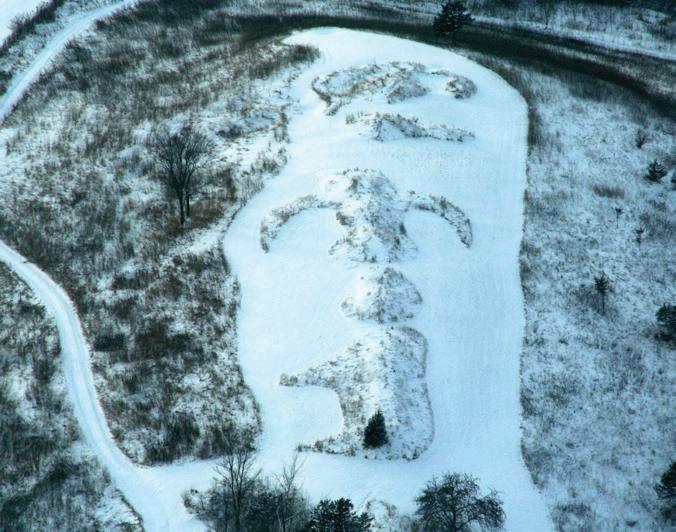

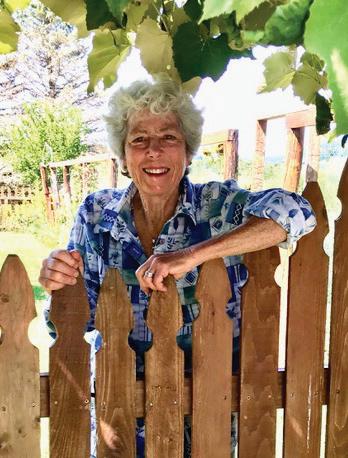
A few days ago I left a message for Ray Ring, village president of the Village of Plain, but he didn't return my call until the next day. When he did, he explained that he had spent the entire previous day using a pick to break the ice off snow in the driveways of five residents before he could use his snowblower to clear the results of the latest storm, and by nightfall was in no condition to talk. “I'm not used to this! It took a couple Tylenol for me to get to sleep,” he confessed. I mentioned to Ray that when we drove through Plain a week ago I noticed that the Three Wise Men hadn't yet made it off the golf course to return to their homes in the Middle East. What with earthquakes and wars, I don't blame them for lingering in the safety of his village, although I'm sure the camels aren't too happy about snow. “My wife has commented on the same thing,” he said with a laugh, “but they are driven into the ground and are still frozen in place. The soil will have to soften up some before we can put them away until decorating next year.”
Camel-wrangling is the least of his concerns as president of a village of 800, plus or minus a few. Plain is struggling to remain viable in an age when this and many other villages and small towns
don't have enough younger volunteers to staff their fire and rescue squads; local businesses are shuttering for lack of patrons – meaning fewer jobs for the upcoming generations; even post offices and libraries in some villages are threatened with closure. The state legislature doesn't share resources with villages the way they once did (Governor Evers is leaning on the opposition party to loosen the purse strings as I write);
there is no full-service grocery store (in the glory days there were half a dozen in operation at the same time); there are fewer places to meet and greet (such as the time-honored I-Diehl Tap, which just closed for lack of someone to take it over from the owner, who retired after 40some years); families are smaller so that schools are under tremendous pressure to consolidate or close (Arena, for instance, lost its primary school, and the building was turned into apartments.) Church-going has declined, and the Catholics don't necessarily send their kids to parochial school anymore. These and other distressing changes generate headaches for those citizens still willing to show up for duty on village boards or attend board meetings to speak their piece. There is no glory to be found in serving, only private satisfaction. Plain still retains most amenities needful for success – a major corporation (Kraemer Brothers construction firms and quarries, recently acquired by Mathy Corp.); a fire department, a picturesque 9-hole golf course traversed by winding Honey Creek; a municipal park for sports, picnicking and swimming pool; a custom butcher; a bank; a casually upscale restaurant; a cheese factory noted for both its sophisticated non-GMO cheeses and its innovative wastewater treatment plant; a plumber; an electrician; a couple of home builders; a furnace installer/ repairman; a beauty salon; a flower shop; an excellent library; a medical clinic; a post office (on shortened hours), a veterinarian; traditional
social clubs such as American Legion and its female Auxiliary, Lions, etc.; an Historical Society Museum crammed with fun old stuff; a Catholic Church with amazing acoustics which musicians of all religious persuasions (or none) want to perform in, and whose Friday fish fry draws thousands annually; two grammar schools; some watering holes where one may sip a beer/order a sandwich/and catch up on the news; an industrial park; two gas stations; a dairy supply/nursery/and hardware store; snowmobile and hiking trails; well-kept residential neighborhoods; garbage pickup and a composting site for garden waste. Justly famous St. Anne's Hill and grotto, where one may undertake a mini-pilgrimage along Stations of the Cross, looms above the village, offering stunning views for those with legs able to climb the steep pitch. Plain has the luxury of being situated amid the exquisite roly-poly hills and bluffs of the Driftless region, steady old families who are loyal and determined that the town be bustling and economically healthy once again, and some new families who share that goal. Police cruise the town, on contract with the Spring Green Police Dept., but the crime rate is very low. When you die, as we all must, there are several historic cemeteries in which to rest for eternity. Additionally, within easy driving or biking distance are American Players Theatre and Taliesin, which draw large crowds from around the world, and many art studios. Ray Ring is descended from one of the old families. His ancestors were in
the second wave of settlers – emigrants from other parts of Germany and Poland and then a rapid deluge from Bavaria. It is that Bavarian heritage the village has been attempting to capitalize on as an thematic magnet, such as hosting Strassenfest (Street Fair) in October and Christkindlmarkt before Christmas. Ad campaigns to make Plain a destination for bike clubs, farm to table tourism, and so on may be paying off. It's hard to tell, he says. A few years ago, Ray and a couple of others sat down and brainstormed about how to make Plain unique or different before coming up with the Bavarian theme. He was skeptical at first, but the family banners mounted on lamp posts, the changing of street signs to both German and English, were paid for from private funds, so, since it didn't cost the taxpayers anything, he agreed. He doesn't want “Bavarianizing” to be overdone. He visited New Glarus to quiz the town's leaders about how focusing on Swiss heritage worked for them and studied similar efforts elsewhere. He
just wants the town to thrive, not merely survive.
Previous Ring males have led the village and been active in committees, as have other family men and women. Few were farmers, mostly small business owners. I asked Ray about his commitment to serving. “To put it in perspective, it's what my parents taught me. I've always told my own kids two things: Give back, and leave the world a better place than you found it. And they do give back. I told them, I'm not asking you to find a cure for cancer or anything. Small things will do. When I was a teenager I worked at my uncle's filling station. He had a
Capitol Report — Marklein: What Is 'Building From Base'?
There is a lot of talk about the state budget these days. Nearly every day, my office is a revolving door of requests and ideas for ways to spend your tax dollars. I am meeting with constituents from all walks of life and people who represent extremely diverse interests. On any given day, I will discuss a dozen different topics from libraries to trails to roads to tourism to schools to taxes to big sports teams to health care to local government.
And in nearly every meeting, I have to explain that the legislature is going to build the state budget from base. What does this mean?
The base budget is our existing foundation. It is the current, ongoing, state spending plan. It includes operating costs and obligations. These operating costs and obligations include personnel, programs that were designed to continue, commitments for buildings, infrastructure and debt.

The base budget does not include shortterm projects or things that were passed as one-time spending. If a bill was passed for the last biennium, without an ongoing appropriation, it, effectively, ends when the

biennium ends unless we vote to continue it. Imagine it this way – every two years, the legislature builds a new house on an existing foundation – the base budget. We add bricks for every spending increase, new investment, new program and new idea. Sometimes we don’t use all of the bricks and we send them back to the supplier – you the taxpayer.
The legislature is going to build the next state budget from base. We are starting with the existing foundation, our current level of spending and any ongoing appropriations that we approved in the past. The base budget is the current, bi-partisan budget we passed in 2021 and Governor Tony Evers signed. This is where we will start.
The legislature will decide whether we are going to add new investments, new programs or new ideas to our current levels of spending. We are truly building from where we are right now.
In the next several months, you may hear that the legislature is “cutting” things that Evers “put in the budget”. This is not true. We cannot “cut” anything that is new spending, a new idea or a new program because we are starting from a base budget. We cannot “cut” Evers’ ideas because they
continued on page 10
do not exist. They are ideas. They are not bricks yet.
Again, in order for something new to be included in the next state budget, it will have to be a brick that is added to the base foundation. If you want us to include a certain brick, please contact me.
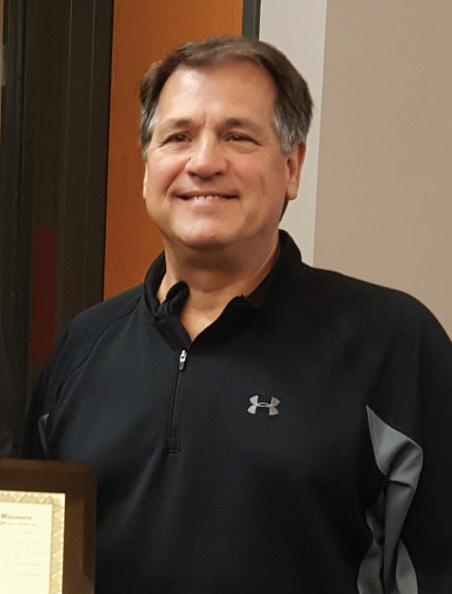
Our design plans for the state budget include agency briefings, public hearings and ongoing communications with our constituents and stakeholders. Agency briefings give the legislature an opportunity to talk directly with our state agencies and ask questions. Public hearings provide the general public opportunity to communicate directly with members of the Joint Committee on Finance (JFC) throughout the state.
Finally, I always want to hear from you and hope you will communicate with me. What do you want to see in our next state budget? If you have ideas for bricks, please let me know. If there are bricks you don’t want us to use, I need to know that too. As always, please do not hesitate to connect with me to provide input, ideas or to seek assistance. Send an email to sen.marklein@ legis.wisconsin.gov or call 608-266-0703. I want to hear from you.
Thursday, March 9, 2023 Page 2 Commentary/Opinion
Katie Green
Katie Green, Columnist
Photo courtesy of the Village of Plain
An aerial photo of the Village of Plain.
Sen. Howard Marklein (R-Spring Green)
Ray Ring
“Sunrise over
mound” (2015) Photo, credit LWSRB
On the cover
effigy
Submit your artwork or photography for cover consideration: editor@valleysentinelnews.com
This photo contributed by the Lower Wisconsin State Riverway Board shows the sunrise over an effigy mound at Frank's Hill in southern Richland County on a past Spring Equinox. Below is the Shadewell Mound Group.
Disingenuous, hyperpartisan state budget updates are feeling tired, why not work together?
If you’ve been reading the regular “E-Updates” Capitol Reports from State Senator Howard Marklein (R-Spring Green; WI-17), you wouldn’t be surprised to see recent updates full of justifications for why the legislature is functioning as it is regarding the budget. He has made it very clear: “The legislature will write THE state budget…the legislature will write the state budget starting from the base budget…The base budget is our existing foundation. It is the current, ongoing, state spending plan.”
In other words, the “base budget” is the budget that was passed two years ago, at least the parts not intended as one-time outlays, with any changes that have been made since it was first passed.
What is missing from his updates, however, is any acknowledgment of what place Governor Tony Evers’ budget proposal actually holds under state law or how it is generated. He could have taken into account the statement regarding the budget on the State of Wisconsin Department of Administration website: “About the

Biennial Budget…Requests are compiled by the State Budget Office for review by the Governor. The Governor is required by law to deliver the budget message to the new legislature…”
There is no necessity, and certainly no excuse, for the legislature to totally disregard the budget proposal presented by the Governor. The Governor’s budget proposal is not “just a list of ideas” as the Senator asserts. It is a formal document based on input from the State Budget Office. There is no question that this budget proposal is presented for review and approval by the legislature. They are free to make whatever adjustments they choose and submit that to a vote of the legislature; the Governor is free to sign or veto it. For the Senator to try so adamantly and continually to make the case that the budget must be a document totally constructed by the legislature, however, is to fundamentally disregard state law.
The Governor is required by law to prepare a budget proposal, the legislature is required by law to pass a budget.
The Governor had listening sessions around the state as he prepared the
budget proposal, he had the input of the State Budget Office and State Departments. What sense does it make for the legislature to ignore this input?
The Senator says, “Imagine it this way – every two years, the legislature builds a new house on an existing foundation – the base budget. We add the bricks… this is where we will start.” That is not accurate. The Governor has already built a house on an existing foundation. Functioning as it does, the legislature totally tears it down – preserving parts it likes to later build back in – and then starts from scratch.
A further point: Marklein says, “The legislature will decide whether we are going to add new investments, new programs, or new ideas to our current levels of spending.” It begs the question of why the legislature should solely have the power to decide this when the voting majority in the legislature received fewer votes in the last election than the Governor?
Partisanship is so 2011. Although it seems the Senator missed that memo. The people and the Senator’s constituents are smart enough to see
Meeting Our Needs — Part 4: Thank a Bug
“Meeting Our Needs” is a series that acknowledges the organizations and individuals who work to make our communities better, stronger, healthier and more inclusive. We know we face challenges and divisions among us, but we miss and underestimate the essential goodness of rural Wisconsinites when we fail to celebrate those who are lifting us up in so many ways. Let us hear your stories, contact bpestel@msn.com to be included in this series.
I have been waging a battle against invasive species in my woods since 1996. Bush honeysuckle, autumn olive and multiflora rose had so clogged my woods I couldn’t walk through them. Handsaws and loppers first, then chainsaws and herbicides, years of battles that created beneficial change. Beneficial because I can walk through my woods now the native plants are dominating, but that is not the whole story. I had a vague sense of the damage these species were doing to my property, but it was not until I met Marci Hess that I began to realize the
Contact us
PO Box 144 Spring Green, Wisconsin 53588 USA
(608) 588-6694
editor@valleysentinelnews.com valleysentinelnews.com
EDITORIAL
extent of the damage these non-native species were doing to our environment and why reestablishing native species is a significant component of meeting our needs. I’ll let her explain…
Marci Hess: Guest Columnist
Why should we care about reestablishing native species in our fields and forests? There may be many answers to that, but insects are a crucial piece.
Insects create a livable world for us.
They keep us healthy, provide us with a variety of food, and they enhance our quality of life. Without them, we would have only wind-pollinated food. Eating would be boring and the lack of diversity in wind-pollinated foods wouldn’t keep us healthy. Insects clean up carrion, poop, and other rotting waste. If they didn’t do this, we would be wading in yuck and dealing with serious health issues. We also turn to insects for design elements, architecture, medicine, and food. We rarely think of insects when we need the spiritual connection of nature and the calming essence of birdsong.
But without insects, we would miss our birds. It’s insects that provide the protein for baby birds to grow. While some adults eat the fruit, babies must have the protein and fat that only insects provide.
I’m often asked what’s the problem with non-native plants? Why do I think natives are better? Don’t the invasive honeysuckles and autumn olives support birds and insects?
All insect species either eat the plant or eat another critter that ate the plant. But when native plants are replaced by non-native plants, insects die, and insect populations are reduced. This then reduces populations of birds, small mammals, reptiles, amphibians, and fish.
Here’s the rub, our native insects have not evolved and are not evolving fast enough to use non-native plants as food. Each plant has a defense against being eaten; this defense can be chemical such as tasting bad or physical such as being hairy. Over time, certain insects have developed the ability to overcome these defenses. They can then use the plant to
through pandering to a base and want to hear real solutions to the real problems they’re facing, without wholly disregarding proposals just because they were made by someone with a different letter by their name. We certainly applaud recent efforts some Republican legislative leaders have been making to meet across the aisle with the Governor. To that end, the minority party as well can’t be a party of learned helplessness and procedural theatrics — just as the Republicans shouldn’t blanket refuse to consider proposals from across the aisle, if the Democrats want to be taken seriously and want to represent the interests of their constituents then they need to come to the table with legitimate proposals. The Governor has done that with his budget.
The budget needs to be negotiated between the Governor and the legislature, beginning with the legally required proposal by the Governor. The legislature should not be empowered to negate the authority of the Executive office, it should be expected only to negotiate with it in good faith.
lay their eggs, knowing when hatched, the larvae will be nourished; this is called a host plant. This evolution has occurred in such a way that not every insect can eat every plant. Much like us, if we all depended on one town to live in, we would decimate it.
Another concern about making sure we have native plants in the environment is awareness of the spacing of these native habitats. Insects don’t travel far. Their range is measured in yards, not miles. In urban areas the term “yards” takes a different meaning. Having native places where insects can traverse and find mates is critical. When these are sufficient, it creates a “corridor” rather than an island. If the insects can move along to other food resources, avoid predation, and reproduce, they thrive. These “corridors” allow for diversity. Diversity — native diversity — creates a balance. A variety of native plants attract a variety of native insects who have predators and parasitoids that create equilibrium. Monocultures and
continued on page 10
Deadlines: The display and classified advertising dead- line is Monday at noon for that week. If you would like our design team to design the ad then please allow extra time for the creative process and proofing.
Editor-in-Chief
Nicole Aimone
Managing Editor
Taylor Scott
Legal Editor
Gary Ernest Grass, esq.
Editorial Policy
On certain topics in areas of great community interest, the editors of the Valley Sentinel may take positions they believe best represent and serve the interests of the community. Any opinions or positions taken by the editorial board are separate and distinct in labeling and substance from the community journalism that appears in the rest of the publication and does not affect the integrity and impartiality of our reporting.

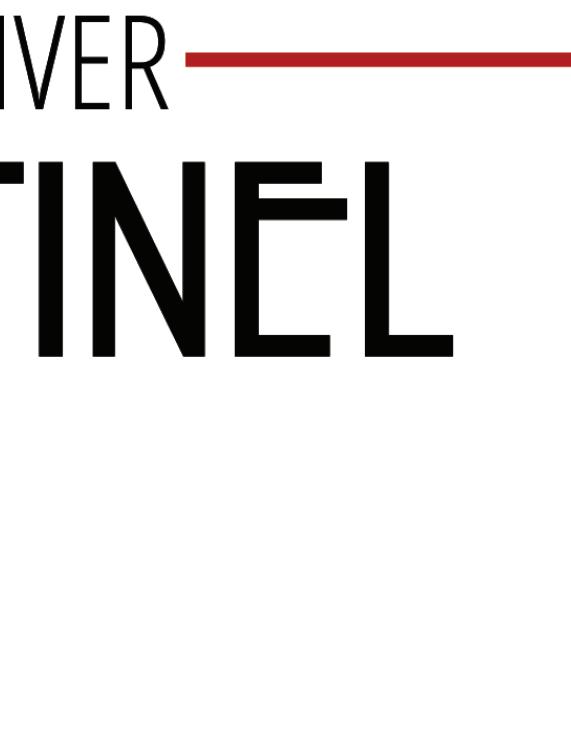

Graphic Design
Julianna Williams
Commentary/Opinion Column
Beverly Pestel
Letter to the Editor Policy
Letters submitted for consideration are subject to fact-checking and editing for space and clarity. Submissions must have a compelling local community interest. Letters to the editor must fit within a 500-word limit, and include name, city and phone number. Phone numbers are for office use only and will not be published. Letters of a political nature, without chance of rebuttal, will not be published the week before an election.
Commentary/Opinion Column
Barb Garvoille
Column Policy
Editors may feature opinion columns written by public figures, members of the public or other publication staff. Columns reflect the opinions of the individual contributors and do not represent positions of the publication. Guest columns of an anticipated length more than 500 words should seek prior editor authorization.
Commentary/Opinion Column
Katie Green
Community Discussion Policy
From time to time the editorial board may select letters to the editor of a particular compelling community interest where a public figure or accountable public action is the recipient of criticism and allow, in the same issue, the subject of the criticism chance for rebuttal, with expounded independent input. The format shall be point, counterpoint and expert analysis. This community discussion shall serve as a moderated dialogue that presents multiple views of important community topics.
Thursday, March 9, 2023 Page 3 Commentary/OpInIon
Subscribe Want the paper delivered to your home or business? Subscribe online at valleysentinelnews.com/subscribe or subscribe annually with your name, phone number, address and $30 sent to: Valley Sentinel, PO Box 144, Spring Green, WI 53588 Have graphic design experience or interested in meetings, events or writing and becoming a community contributor? Let us know. Thank you to all of our contributors for believing in our community.
team: ads@valleysentinelnews.com Valley Sentinel is an independent, editor-owned, all-volunteer, free bi-weekly news publication, available on newsstands in the area. Covering Arena, Lone Rock, Plain, Spring Green and the surrounding areas in Sauk, Iowa and Richland counties. Est. 2020 igne conflatum “Forged in Fire” Valley Sentinel is published in Spring Green, Wisconsin every other Thursday by Lower Wisconsin River Valley Sentinel, LLC. ISSN 2694-541X (print) — ISSN 2694-5401 (online) Member, Wisconsin Newspaper Association REGULAR CONTRIBUTORS IN THIS EDITION Full and up-to-date policies available at: www.valleysentinelnews.com Note: This edition printed March 15 due to press delay, staff illness and weather. Be sure to check our website for delays and updates.
Ad
EDITORIAL
Beverly Pestel, Columnist
LETTERS TO THE EDITOR
Dear Editor,
I’m an independent voter and I’m attempting to make sense out of the rhetoric concerning the next State budget. As required, Governor Evers gave his budget address. He stated what he thought would be the best for us inhabitants. Immediately Senator Marklein
Dear Editor,
The recent decision by the UW System President to end in-person instruction at UW-Richland should concern every Wisconsinite. Not specifically because of its impact on the Richland Center community, but because of the way decisions are being made about our taxpayer funded universities without public input. It’s time to say STOP, and then force UW System to follow their own rules to guarantee public input and open government.
In 2017, the then-UW System President abolished UW Colleges, and attached our 13 two-year campuses to our fouryear universities. This action was taken
Dear Editor,
How dare you, Arena Village Board member Kristin Shea?
After reading and thinking about your comments in the area newspapers about Steve Jahnke’s letter regarding the turmoil caused by the Village over EMT funding, I’m perplexed. Why would a Village Board member feel it is ok to slam a dedicated professional such as Mr. Jahnke. This man sits on the Fire Board and is a dedicated volunteer for our community. The fact that he does not live in the Village has no bearing on him being able to express his opinion and his facts.
The Village Board eliminated a Police officer position due to a lack of oversight in budgeting since 2019. “Decisions made today, affect a municipality, for
chose to call it “list of ideas.” “It was not the state budget.”
Okay, now this is where I begin to have trouble understanding. Is expanded funding for education just an “idea”?
As a retired educator I hope the funding for education is not just an “idea”.
Is adequate funding for our crumbling
by the President and quickly approved by the Board of Regents without a public hearing, which was required by Regent policy. They said the action was needed to improve educational options, bolster enrollment, and avoid closings. The counties and cities, which own and have invested over $400 million of tax dollars in the 13 two-year campuses, were not consulted or even informed in advance. Nor were the leaders of UW Colleges. Since then, enrollment at the twoyear campuses has plummeted and a UW campus is effectively being closed. These are hardly the results promised by System leaders in 2017 and there seems to be little, if any, accountability for their
years down the road” and the decisions made since 2019 are catching up to this Village. By losing a Police Officer, the Village basically lost two employees and the Town lost one employee. The officer was also an EMT.
No, the Village can’t fund everything, but, the Village should be able to pay their share for emergency services. Your comment, “Perhaps the Town of Arena should contribute to the police, and the Village could then afford to contribute more to Fire/EMS” is an example of not thinking. The Town already pays the bigger share of the expense. Most of the calls for EMT service originate in the Village. So, you could say, that while the Village pays for police protection in the Town, the Town pays for EMT service in the Village.
EDUCATIONAL OPPORTUNITY
WE'RE LOOKING FOR INTERNS AND COMMUNITY CONTRIBUTORS
Looking for a challenge?
We are looking for interns/volunteers who want to be in the unique position to learn the nuts and bolts of a news media publication that started from the ground up.

You will have the chance to make an impact at the ground level of a startup and see the effect of your work and ideas carried out with a lot of flexibility, in an environment and creative culture you can help influence and create.
Available subject areas:
EDITORIAL/JOURNALISM SOCIAL MEDIA
ADVERTISING/MARKETING
GRAPHIC DESIGN/PAGE DESIGN/LAYOUT DISTRIBUTION/CIRCULATION/CRM MNGMT

PODCASTING/AUDIO PRODUCTION
AND MORE!
We are a new, all volunteer local news source that holds a strong belief that by working to keep our communities informed and engaged on a variety of topics including arts & culture, events, community news and serving as a watchdog for our local governmental bodies, we can help create a strong identity for our community and ignite positive growth and change throughout the area.
Interested? Send us your area(s) of interest and a resume to: editor@valleysentinelnews.com
Internship will be unpaid, interns will be required to sign a FSLA-compliant internship agreement. If credit is available from intern’s educational institution for participation in an internship, we are glad to work with you to meet any requirements for receiving credit.
Want to help build community? Know a college student that’s looking for a summer or fall internship for academic credit or to gain experience? Already attending village board or school board meetings and want to record or report on them? Want to engage with arts & culture, ag, businesses and other topics important to our community? Want to take scenic walks or drives delivering papers to subscribers and businesses?
We have so many ideas to grow and do more for our community, but we need help, we CAN’T do it alone. If you want to be a part of something bigger please email us and let us know what your interests are: editor@valleysentinelnews.com
Areas in most need:
-Graphic design (publication layout, visual story design, infographics)
-Sports reporting
-Municipal meeting recorders/reporters
-School board reporters
-Social media posting/creation
-E-newsletter
-Website posting


-Agriculture reporter/columnist (current events)
We have the infrastructure set up for most of these areas, we're just in need of manpower from passionate community members.
infrastructure just another “idea”.
Recently Senator Marklein wrote “every two years, the legislature builds a new house on an existing foundation – the base budget.” “The base budget is our existing foundation.” “It is the current, ongoing, state spending plan.”
Well now, am I to assume that the
actions. Enrollment at most two-year and four-year campuses continues to slide even though the state population, demand for college educated workers, and need for higher paying jobs are all trending up. And now the UW System leader’s answer is to close campuses instead of making it easier for Wisconsin taxpayers to benefit from a higher education?
If you’re not interested in what happens in Richland Center, look at the more rural UW campus near you; the one you or your child may be interested in; the one with tuition that may be half of what it costs at UW-Madison; the one that educated the teachers, doctors, and dentists in your community. Is that campus next? Unless
The Police also protecting the Town is called mutual aid. This benefits the Iowa County Sheriff's Department and in turn, Iowa County helps out in the Village. About the Referendum. First, you say the wording was the same used in 2020, as approved by the Village Attorney. Then you go on to say “some additional explanatory wording was included to make sure the voters knew the effect of their vote. The DOR put the referendum in question due to a wording issue.” Since there was no problem with the wording in 2020. Wouldn’t you say the added wording threw the DOR off? Was the Village Attorney included in on the added wording? Shouldn’t the Referendum have been sent to the DOR first for approval and then voted on? I believe that is the proper way to do it.
“ideas” are not part of the state spending plan?

Senator Marklein stop the shenanigans and send a clear, transparent message.
Bill Cary Rockbridge, Wisconsin
we say STOP, we will find out only after the decision is already made.
Please contact your legislators and demand that Governor Evers create a task force to come up with a plan for the future of higher education in the State of Wisconsin, and that NO campus will be closed until this is done. If UW System won’t listen to the people, we need another way for Wisconsinites to speak their minds. These decisions are too important to be made behind closed doors.
Rachel Schultz
Jean Birkett Richland Center, Wisconsin
The Village Board should be running the day to day workings of the Village. The Village Clerk’s role is a support role. The Village President and two other members on the Board are multi-term members and they still cannot run a meeting effectively. They still ask if a motion should be made or how to proceed. How do I know this? I attend and record the meetings.
Being a Board member is as hard as you make it out to be. If you study, read Robert’s Rules and your board packet, you will be effective and not have to rely on one person. No one knows everything, but a point should be made to know something.
Paul Pustina Arena, Wisconsin
CLASSIFIEDS
Healthcare Employment Opportunities
*Director of Marketing – full-time management position

*Director of Obstetrics – full time nursing management position
*Director of Health Information Management – full-time management position.
*RN Float Nurse – .75 FTE evening/night shift position! Employment Bonus Eligible!
*ICU RN – .9 FTE evening/night shift position. $4,500 Employment Bonus Eligible!
*OB RN – .9 FTE evening/night shift position. $4,500 Employment Bonus Eligible!
*RN Emergency Department – .6 to a .9 FTE p.m./night shift position. Employment Bonus Eligible!
*RN – .5 FTE p.m. shift position in our Nursing & Rehab Center
*Certified Nursing Assistants – part-time positions available in our Nursing & Rehab Center on day, evening and night shifts, $3,000 Employment Bonus included!
*Certified Nursing Assistants – .5 FTE day shift & .6 FTE p.m. shift on our Med/Surg unit.
*Occupational Therapist – full-time OT position working in Home Health and in the Schools.
*Physical Therapy Assistant – .8 FTE in our Home Health Services Department.
*Physical Therapy Assistant – .8 to 1.0 FTE combination position working in Home Health and Outpatient Services!
*Speech Therapist – .6 FTE Day shift position.
*MRI Imaging Technologist – .5 to a 1.0 FTE day shift position. Up to a $5,000 Employment Bonus, prorated based on FTE!
*Imaging Technologist – full-time night shift position. Up to a $5,000 Employment Bonus, prorated based on FTE!
*Imaging & Lab Technologist – full-time position working 4 -10 hour day shifts in our family practice clinics.
*Respiratory Therapist – .5 to .6 FTE day shift & a .6 to a .9 FTE evening/night shift.
*Med Tech/MLT or CLS – .6 FTE Premium Pay Weekender Day shift position.
*Operating Room Technician – .8 FTE day shift position. $3,000 Employment Bonus eligible!

*Patient Access Specialist – .5 to .6 FTE p.m./night shift & a .8 FTE night shift position!
*Clinic CMA or LPN – .75 to .9 FTE day shift position in our Mineral Point & Dodgeville Family Practice Clinics & a .8 to 1.0 FTE float position in our Specialty Clinics.
*Environmental Services Staff – full and part time p.m. and night shift positions. $1,000 Employment Bonus!
To find out more detailed information about all open positions and to apply, go to our website at www.uplandhillshealth.org
Upland Hills Health
800 Compassion Way Dodgeville, WI 53533
Thursday, March 9, 2023 Community/OpInIon Page 4
Reflections from Lost Horizon Farm — Barn Cats
Each edition, retired dairy farmer Barb Garvoille brings her musings on dairy farm life from her own years of experience on Lost Horizon Farm with her late husband Vince “Mr. Farmer” Garvoille. This mooving memoir focuses on 19802000, join Barb as she rises with the herd.

Photographic images of farm life almost always include a picture of a farm cat atop a milk can, on a hay bale or an implement, curled up somewhere by the farm buildings, or lapping milk from a dish. With a wooded ridge running parallel to the eastern side of the barn, the farm cats at Lost Horizon Farm provided that rural snapshot on cooler days by appearing framed by the barn openings as they would sit in them absorbing the first warming rays of sunlight coming over the ridge. One of our first morning chores was to fill the cat dish in the haymow. Lost Horizon Farm cats were always supplemented with dry, high protein food. Their cat chow bag was placed inside a galvanized steel garbage can with a cement block on its lid to prevent clever raccoons from getting into the food and scattering and spoiling it. These masked bandits/nuisances would chew their way through any plastic garbage can where an appealing scent lingered and could easily use their paws to pry off a steel lid unless it was weighted down. A hallmark of raccoon activity could be a ripped bag or the telltale insult of defecation on the food supply.
Farm cats were cued into feeding time; the sound of the garbage can lid being removed was their conditioning call. They knew to vie for a strategic position because once the food was consumed, it was gone for the day! At times a person would have quite the hunt to find the food dish. Our raccoon friends were sometimes so enamored with the scent of the dish that one might carry it off somewhere. One day, the missing stainless steel dish was found in the pasture across the highway. It was discovered only because sunlight glinting on its contours revealed its position in a flashy way.
A farm is a feline nirvana because of the number of rodent prey items available, but it is also a very dangerous place to live. Any cat that would be in the wrong place when a cow moved in her stanchion could be pinned under a very heavily weighted bovine foot and thereafter drag a useless leg or display a broken tail. Cows were absolutely oblivious to the pained yowls of a cat. If a cat decided that the bedding underneath a cow was a good place to sleep, it would become a very flat cat when the cow decided to lie down. Mr. Farmer called these casualties “rugs.” Cows weigh between 1200 and 2000 pounds; once
their front legs bend, they can be prone in a second and are unaware of any feline being crushed or suffocated beneath them.
Savvy barn cats learned to confine their terrestrial wanderings to the alleyways, the walkway or the manger when the barn

was full of cows. A fair number mastered the technique that allowed them a drink of water in the barn. These cats would jump up, perch with their toes grasping the thin, rounded edges of a cow's drinking cup, balance, and then bend to lap water. More territorial cows would bunt the drinking cats off their cups; others would massage the felines with their wet, rough tongues. Some cats would behave like tightrope walkers, passing above the cows as they paced along the pipeline. These acrobats had figured out that during milking, the pipeline offered a pleasingly warmed highline route. The most successful hunting cats gathered around feed slides because they knew that mice and, sometimes, a real bonanza, a nest full of baby mice, might come down with the flowing grain. Ever hopeful and opportunistic barn cats also learned to stand on their hind legs and peer into pails. Mice would crawl into empty pails from time to time and be unable to jump out of the taller five-gallon ones.
Experienced mother cats chose to deliver their kittens upstairs in the haymow where it was warm amidst the bales and a lot safer for the kittens to explore and play (unless they ventured too close to an open chute). Kittens born in the cow barn were usually doomed to death by cow unless the mother cat would accept a human attempt at relocating the kindle to the haymow.
Cats liked to crawl into and on top of machinery in their search for rodents. A person grew accustomed to banging on the hay elevators or grain conveyors to convince cats to vacate before the equipment was operating. One Lost Horizon cat lost her hearing after being hit by a grain elevator paddle.
Additionally, cats and kittens faced the danger of depredation by other cats (particularly from the good-sized, male, feral cats farmers called "woods’ cats"), dogs, raccoons, coyotes, and Great Horned
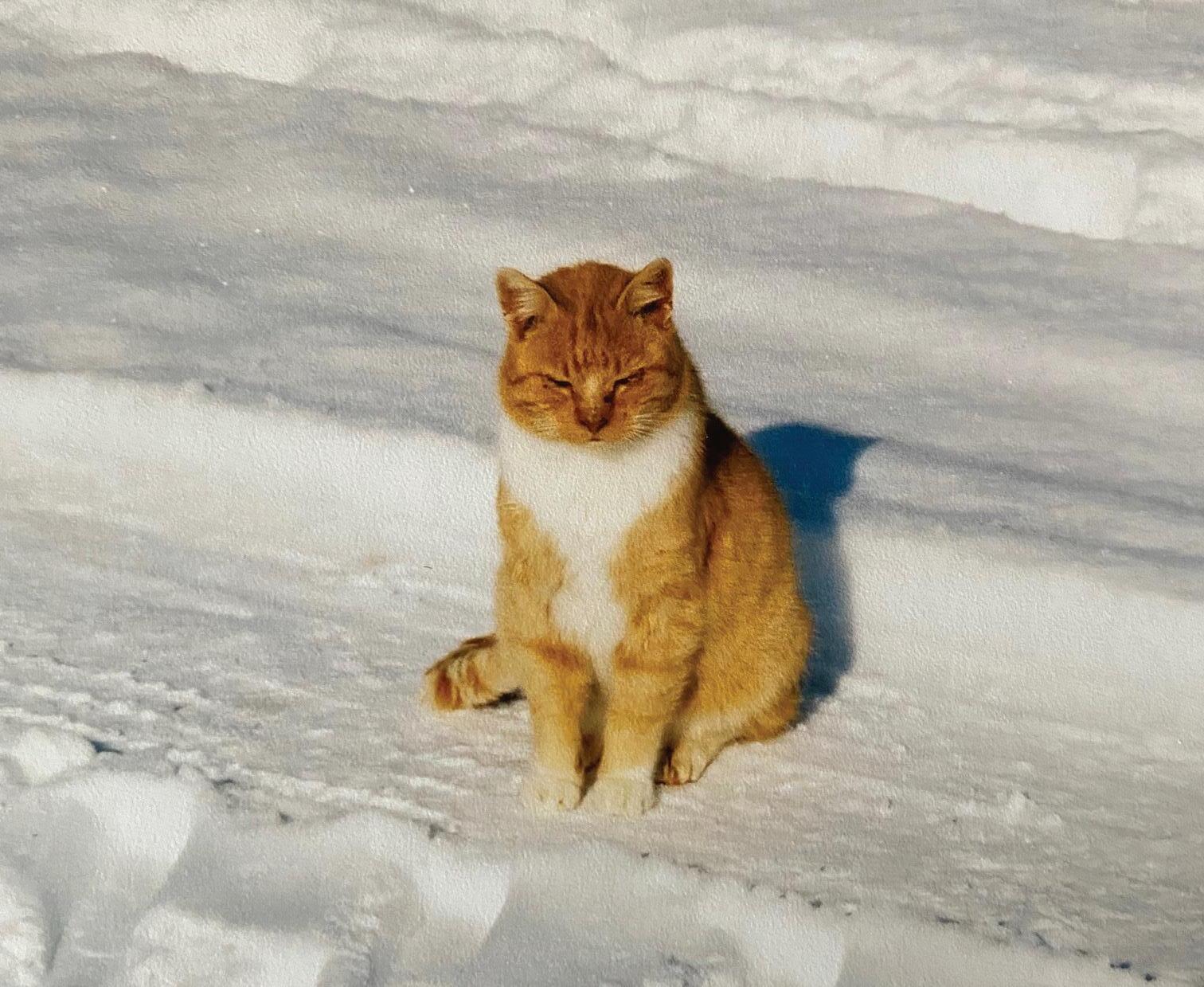
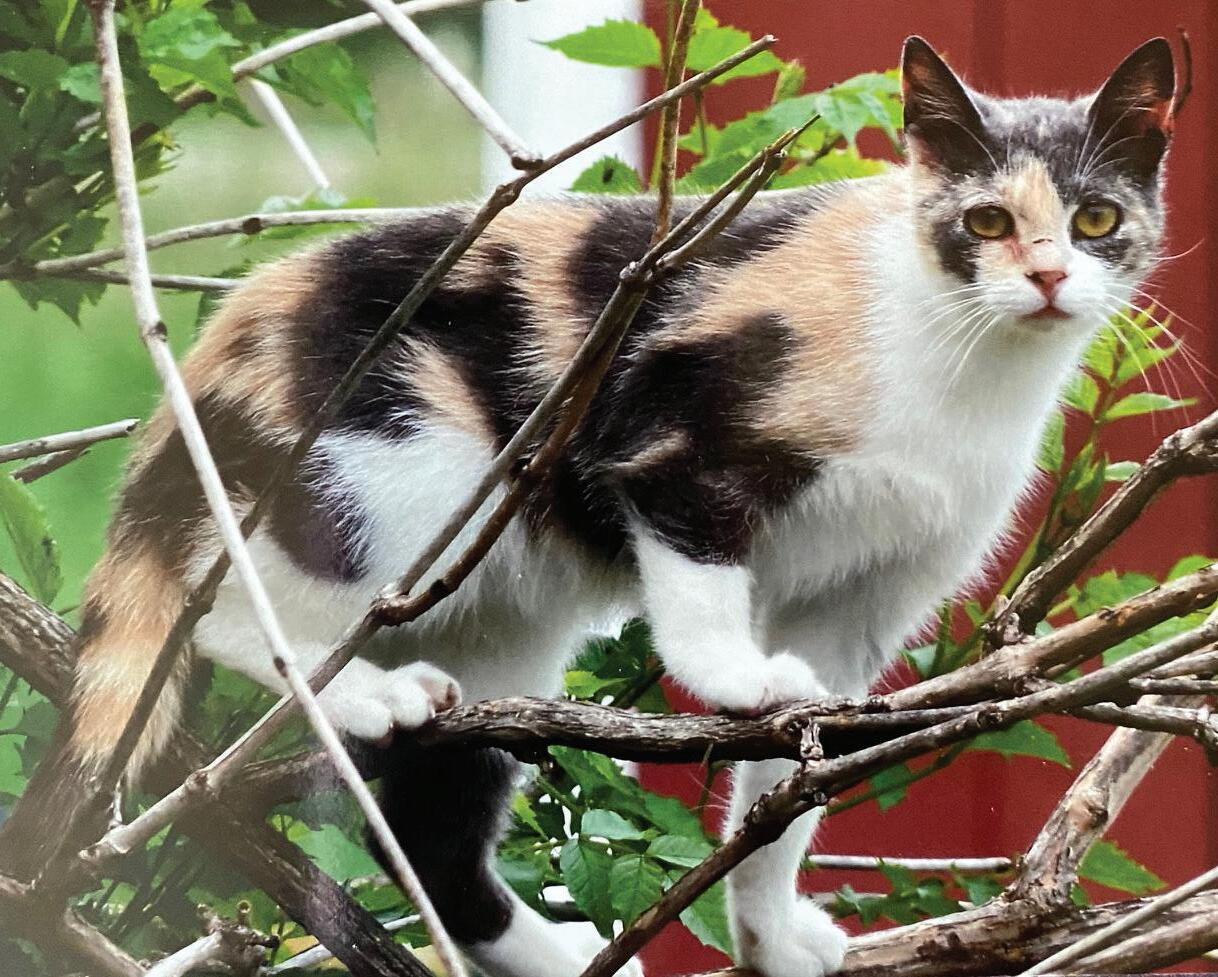

owls. Feline survival was also contingent on avoiding vehicles on the highway and on the farm road. Any cat hunting on cropland needed to get out of the path of machinery, especially cutting and harvesting equipment. The majority of the felines on Lost Horizon Farm, although tolerant of human presence, were not tame and, therefore, impossible to catch. Diseases, endemic to the farm or brought in by visiting cats, were an ongoing threat and killed unvaccinated cats and kittens. With so many factors working against their survival, cats came and went on Lost Horizon Farm. Sometimes the demise of a particular cat was apparent, like a road kill or a "rug," but, at other times, a cat would simply vanish, and a person could only guess what might have happened to it. Perhaps the sorriest of felines were the “dumps” — pets that people abandoned by the farm. Oftentimes these unfortunate animals met their end rapidly before they could adapt to the many abrupt changes inherent in transitioning from a house cat to a farm cat. Because of the high turnover rate, cats were seldom named. A handful of named cats that had some unique or distinguishing feature included: Buttsie the Arrogant, who was given to lying in the middle of the highway when the tarmac was warmed by the sun and wrongly thought himself immortal; Tennessee Tuxedo who was just too beautiful (and
vain) in his elegant hair coat of black and white and immediately noticeable by his prancing gait; and Owen, the Outcast, who was not only a coward of the first order and bullied by all of the other cats, but also an oddity because he refused to eat mice. Sebastian, the Show Cat, was one of the few tamed and truly friendly cats who had the singular honor of having been vaccinated in a veterinarian's office and also of having won a red ribbon at the River Valley School Fair! There was one adult female cat we called “The Black and White Mother Hunting Cat.” She lived solely in the hay storage shed and was never spotted in or near any other farm building. The visual of this cat could best be described as a quick glimpse, a bolt, as she endeavored to hide herself further amongst the hay bales. Sometimes she appeared as a speck hunting far, far afield. After nearly a year, this very independent cat joined the ranks of the “disappeared.” She was around, and then she wasn’t.
Barb has called Lost Horizon Farm, just north of Spring Green, her home for the past 43 years. She is fond of all creatures (including snakes). Her joy stems from being able to be outdoors every day observing and treasuring the plant and animal life on her small piece of this planet. She loved milking cows and is proud to have been a dairy farmer.
Thursday, March 9, 2023 Page 5 Commentary/AGrIcuLture
Barb Garvoille, Columnist
Barb Garvoille
Photo contributed by Barb Garvoille Barn cats are climbers.
Photo contributed by Barb Garvoille Pictured is Owen, the Outcast.
Photo contributed by Barb Garvoille Sebastian, the show cat, with his ribbon.
COmmunitycalendar

Events for March 10 - March 23



Friday, March 10
Tuesday, March 14 cont.
Project Yellow Art Show 4:30 PM - 6:00 PM
The Wyoming Valley School, 6306 State Road 23, Spring Green wyomingvalleyschool.org the mission of project yellow is to expand awareness of the capabilities and creative talents of students with disabilities by providing an avenue to showcase their artwork. Participating schools: Dodgeville, Lancaster, Platteville, Prairie Du Chien, Richland Center, River Valley.
Saturday, March 11
Spring Green Farmers Market 10:00 AM - 11:00 AM S230 E. Monroe St., Spring Green Spring Green Farmers Market Is a year-round outdoor market offering seasonal produce, local meats, baked goods and many other wonderful items. Held outside the Spring Green Community Public Library every Saturday morning. Preorders are recommended. Visit our Facebook or Instagram page or email SGFarmersMarket@gmail.com for a list of participating vendors and their contact into.
All Ages Storytime 10:30 AM 230 E. Monroe St., Spring Green springgreenlibrary.com Join Hannah, our new Youth Services librarian, for her first month of Storytime! March is all about food. Over the course of the month, we'll talk about going to the store and the market, how food is grown, international dishes and customs, what animals eat, and have a special session all about pasta. Bring the whole family, and enjoy food-themed stories, songs, movement, and more!
LIVE MUSIC: Bluegrass Jam 1:00 PM - 3:00 PM Spring Green General Store, 137 S. Albany St., Spring Green 608-5880-707, karin@springgreengeneralstore.com, SpringGreenGeneralStore.com Free event. All ages welcome! Bluegrass Jams will be held on the second Saturday of each month. While the weather permits they'll be held on our back deck. Bring your instrument and play along or come to listen; all are welcome.
Movies, Munchies and More: Mrs. Harris Goes to Paris 1:00 PM 230 E. Monroe St., Spring Green springgreenlibrary.com Every Tuesday at 1pm, come to the Library for a cup of coffee, a sweet treat, and either a movie or a presentation. Join the Friends of the Library group as we enjoy the movie, Mrs. Harris Goes to Paris (2022). Movie Synopsis: A widowed cleaning lady in 1950s London falls madv in love with a couture Dior cress. and decides that she must have one or her own (rating: PG).
Maple Tree Tapping 1:30 PM - 3:00 PM Miracles on Hoof, Between Spring Green and Plain For more info, look up Miracles on Hoof on Facebook Paul Hartrick has a forestry degree from UW Stevens Point and has been tapping trees for maple with his family for more than 30 years. Paul is excited to educate the youth about the process and tap our trees for a great cause. Donations accepted.
LIVE MUSIC: St Luke Gala 5:30 PM Dorf Haus, Roxbury stlukecatholicchurchplain.com All Proceeds Benefit St. Luke Catholic School. Tickets: $50 per person. Ticket sales end March 4th. Online auction: BiddingForGood.com/stlukecc. Food and Live music from Midnight Divas DJ and plenty of great company.
LIVE MUSIC: Violet Palms 7:30 PM - 9:30 PM Slowpoke Lounge, 137 W Jefferson St., Spring Green slowpokelounge.com Suggested donation of $5-10 A late 90’s early aughts styled band with both original music and favorites, featuring: Marcus Truschinski on vocals, Ben Feiner on guitar and vocals, Craig Benzine on guitar, Mike Mertins on drums, Tim Gittings on bass, and more!
Sunday, March 12
Winter Yoga 8:30 AM - 10:00 AM Radiant Spirit Yoga, S7163 County Rd. G, Hillpoint ruralremedy.com Contact Emily for pricing at embenzgmail.com This series will help you build a regular movement and mobility practice based in the yoga traditions. Regular mindful movement can reduce your susceptibility to injury, contribute to your longevity, help you find some freedom, and just feels darn good.
LIVE MUSIC: Slowpoke Songwriters Round 6:00 PM - 8:00 PM Slowpoke Lounge, 137 W Jefferson St., Spring Green slowpokelounge.com No cover, but tips for artists are always welcome Featuring Katie Scullin and Travis Worth. Tim Eddy curates this series of singer/songwriters from the Driftless Area, the second Sunday of every month. Support local artists by joining us for a night of original music with several songwriters, all on the stage together, sharing their music round robin style.
Monday, March 13
A Night of Words 7:30 PM - 9:30 PM Slowpoke Lounge, 137 W Jefferson St., Spring Green slowpokelounge.com An open mic. Friends sharing words. Watch. Listen. Speak. Share. Maybe you have a favorite poem, or passage from a book you’d like to share. Or maybe you write your own and are ready to share it with the rest of us. Maybe you just want to tell a story. Or maybe you just want to listen. It’s all good. Let’s hang out and share words together. Poetry. Stories. Original work and old favorites. This and that. A Night of Words.
Tuesday, March 14
Winter Family Storytime 10:15 AM - 11:00 AM Plain Kraemer Library and Community Center, 910 Main St, Plain kraemerlibrary.org Fun stories, songs, and themed activities each week for children and their caregivers. Stories and songs 20-30 minutes followed by craft/activity. Children under 6 must be accompanied.
Community Potluck 11:30 AM - 1:00 PM Spring Green Community Center, 117 S Washington St, Spring Green springgreen.com Bring a dish to pass! All are welcome!
Ending time is an estimate only and varies.
Movies, Munchies and More: Respect 1:00 PM Spring Green Community Library, 230 E. Monroe St., Spring Green springgreenlibrary.com Every Tuesday at 1pm, come to the Library for a cup of coffee, a sweet treat, and either a movie or a presentation. Movie Synopsis: Following the rise of Aretha Franklin’s career from a young child singing in her father’s church’s choir to her international superstardom. “Respect” is the remarkable true story of the music icon’s journey to find her voice and become the Queen of Soul. (Rating: PG-13)
A Brave And Lovely Woman Virtual Book Release 6:30 PM - 7:30 PM Virtual event taliesinpreservation.org Join Taliesin Preservation, University of Wisconsin Press, and author, Mark Borthwick for the virtual release of A Brave and Lovely Woman. The evening will start with a presentation, followed by an audience Q+A.
Zoom Party: Virtual Release and Q&A with the Author 6:30 PM - 7:30 PM Spring Green Communinty Library, 230 E. Monroe St., Spring Green springgreenlibrary.com Join us at the library to watch via Zoom the Taliesin Preservation and University of Wisconsin Press event for the new book, "A Brave and Lovely Woman" by Mark Borthwick. This book is the first detailed portrait of Frank Lloyd Wright's fascinating and complex mistress, Mama Borthwick. We will start with a presentation, followed by audience Q&A.
Wednesday, March 15
All Ages Storytime 10:30 AM 230 E. Monroe St., Spring Green springgreenlibrary.com Bring the whole family to the library for a morning of song, stories, movement, and fun!
Winter Yoga 6:00 PM - 7:30 PM

Wyoming Valley School, 6306 State Road 23, Spring Green ruralremedy.com Contact Emily for pricing at embenzgmail.com This series will help you build a regular movement and mobility practice based in the yoga traditions. Regular mindful movement can reduce your susceptibility to injury, contribute to your longevity, help you find some freedom, and just feels darn good.
Arcadia Book Club discusses "The School for Good Mothers" by Jessamine Chan 6:00 PM - 7:00 PM This is a zoom book club meeting readinutopia.com Issues of race, mental health, gender imbalance in parenting, and the faux perfection of social media working against Frida may cause ire in the reader but not enough to keep you from racing to the final page of this excellent, captivating debut novel. Big Brother is watching...and so is the robot baby. This book is The Stepford Wives x The Handmaid’s Tale x 1984 level terrifying.
Thursday, March 16
Storytime 10:30 AM Lone Rock Community Library, 234 N Broadway St, Lone Rock
Join us

Thursday for storytime!
Stitch and Bitch 1:30 PM - 3:00 PM Spring Green General Store, 137 S. Albany St. Spring Green springgreengeneralstore.com The Spring Green General Store’s Stitch and Bitch handwork group meets Thursday afternoons weekly. All are welcome. Knit Night at Nina’s 6:00 PM - 8:00 PM Nina’s Department Store, 143 E. Jefferson St. Spring Green ninasdepartmentstore.com Every Thursday from 6 to 8 pm. All knitters and crocheters are welcome. Store closed after 5:30 pm.
Bingo at Arthur’s Supper Club 6:00 PM - 8:00 PM
Arthur’s Supper Club, E4885 US-14, Spring Green arthurssupperclub.com Every Thursday evening we play 7 games of Bingo. Bingo is FREE, we just ask that people order beverages and/or food. We do ask that Bingo goers are at least 18 years of age to play. We have prizes for the winner of each game...some are cash, gift cards, and other fun stuff that is donated from time to time by businesses.
Friday, March 17
LIVE MUSIC: Sh*tty Barn Season Announcement 2023 — Kiss The Tiger at the Slowpoke 7:30 PM Slowpoke Lounge, 137 W Jefferson St., Spring Green slowpokelounge.com shittybarnsessions.com Tickets $25 in advance Bar opens at 5:30 Join us as we make this St. Patrick’s Day extra-lucky by hosting our Season Announcement Show featuring Minneapolis’s Kiss the Tiger.
Saturday, March 18
Spring Green Farmers Market 10:00 AM - 11:00 AM S230 E. Monroe St., Spring Green Spring Green Farmers Market Is a year-round outdoor market offering seasonal produce, local meats, baked goods and many other wonderful items. Held outside the Spring Green Community Public Library every Saturday morning. Preorders are recommended. Visit our Facebook or Instagram page or email SGFarmersMarket@gmail.com for a list of participating vendors and their contact into.
Author Event: Sue Berg 11:00 AM Community Room, Spring Green Community Library, 230 E. Monroe St., Spring Green springgreenlibrary.com Sue Berg is the author of the Driftless Mystery Series. A mystery series set near La Crosse, with the main character of police officer Jim Higgins. Sue will discuss her journey as an author as well as the timely and local series. There will be copies for sale after the event.
Layton-Brown Memorial Scholarship Bean Bag Tournament 11:00 AM Nina’s Department Store, 143 E. Jefferson St. Spring Green ninasdepartmentstore.com Team Tournament. Pre-registration is RECOMMENDED call/text Nicole @ (608) 412-5788 OR Bill @ (608) 588-5156. Entry fee $20 per team. Bring your own parter!! Double Elimination, 6 games guaranteed! If you don’t have a partner let us know, there maybe some else looking for a partner as well! Play set-up: Every Team will play 4 single games, race to 21. Teams will then be split between a social and competitive bracket based on the amount of points scored from those 4 games. Payouts in both brackets! Layton-Brown Memorial Scholarship will go to selected Graduates River Valley School in Spring Green attending a Vocational/Technical College! Any questions, please reach out to Nicole!

Garden Planning with RVACG 1:00 PM Community Room, Spring Green Community Library, 230 E. Monroe St., Spring Green springgreenlibrary.com Join the River Valley Area Community Garden (RVACG) for a free garden planning workshop open to all gardeners and aspiring gardeners. We will cover the basics of pre-season planning. Suitable for gardeners of all experience levels Whether or not you plan to garden with RVACG this year.
STS & VICKI 1:00 PM - 3:00 PM Spring Green General Store,137 S. Albany St., Spring Green springgreengeneralstore.com STS is a MKE native, a musician of the late 70’s and 80’s scene. Vicki is a Chicago native whose musical experiences began as a classical violinist. Her style is influenced by playing in a symphony orchestra as well as a variety of musical groups performing bluegrass, folk, rock and a variety of international flavors.
Celebrate The Luck Of The Irish with Wit and Whimsy Program to benefit Spring Green Community Center 2:00 PM Spring Green Community Center, 117 Washington Street, Spring Green The Spring Green Community Center will host an afternoon benefit concert of Irish Story with local word artist, Cecilia Farran. All ages are invited to sit back and enjoy the fun as Cecilia delves the Irish tradition and her expressive voice takes you to an ancient land of mystery, legend and everlasting beauty. There will be an ample bit of Irish humor, epic myth. whimsey, poetry and magic thrown in.

Thursday, March 9, 2023 Community Page 6
every
very V
The Community Calendar is curated and designed by Julianna Williams. Events are subject to change, always check ahead for up-to-date information on any events you are interested in.
Recently, we announced the soft launch of a semi-regular to regular literary section we've been inspired by other literary compilations to call Lexington & Jefferson
As the pivotal intersection of our community, we envision this as a place that celebrates the cross-section of our greater community.
We envision it as a place of curated and submitted prose, poetry and more that showcase the talents of our community.
Introducing Lexington & Jefferson
Each edition we receive submissions of artwork, poetry, prose and other musings that we have trouble placing in the paper on their own and often have to simply hold or regrettably turn down.
We hope this becomes a welcome place for them. This space will grow and change, as all things do, and we welcome talented individuals, organizations, authors, experts and artists to help curate this section - perhaps we'll compile and publish an





Lexington & Jefferson
Musings from the End of the Rainbow
Take a journey with me to the end of the Rainbow.
annual literary journal, who knows.

We may also use this space for arts & culture news and submitted musings that don't quite fit within the bounds of a traditional column, profile or letter to the editor.
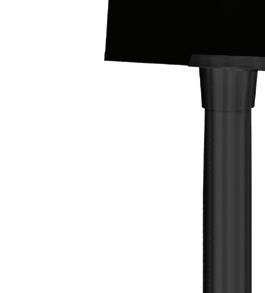
Get involved: If you're interested in submitting, curating or have ideas, please don not hesitate at all to submit them to us at: editor@valleysentinelnews.com

LITERARY SECTION
I grew up at the end of Rainbow Road, a beautiful and magical place in a River Valley, just outside of a town called Spring Green. Following are stories and reflections of a simpler time.....
The Awakening
During winter, the earth is at rest, getting its beauty sleep, covered in a blanket of snow. In the early morning hours driving along a country road, magic is everywhere as the hoar frost sparkles and dances across the landscape.
Our earth seems like an innocent child snuggled in bed, fast asleep in its onesie, waiting to be awakened by Spring’s joy and wonderment.
That’s how I view my surroundings as I begrudgingly move thru these winter months.
Once the snow begins to melt and the days grow longer, we start to see the landscape’s arms stretch and our little corner of the world yawn as it awakens. Faint light green begins to speckle the surrounding hillsides and with each day becomes more vibrant as the “sleepies” are wiped out of mother nature’s eyes.
With the spring rains, comes an explosion of greenery. Every shade one can imagine and even some that you can’t, will coat the hills and valleys. It’s as if overnight someone shouted, “Wake up, show yourself!! it’s time to reward everyone for their patience”.
Upon spring's arrival, the fields are prepared for planting.
My father was the King of Melons. The field to the left of the barn, toward Neuheisel’s hill was knighted the melon patch.
When planting day arrived dad would gather us up, Me, Lulu, Tom and Donata and herd us out to the field. Yes, we were all barefoot. What good is living on a farm if you can’t feel the warm dirt squishing between your toes?
Off we would run, with unbridled enthusiasm, following dad one by one, single file into the field, him carrying a hoe and each of us tightly clutching our bag of seeds.


Dad would create a two foot long by 3-inch-deep trench and we would dutifully, with extreme care, drop in the instructed amount of seeds. Up and down the rows we would follow him, placing the seeds with such gentleness. My brother Tom following, covering each bed: with a blanket of soil. It would take an entire day to plant that field, but it never seemed like work, how could it? We were outside: running, laughing, barefoot and carefree.
Once complete, the waiting began, like the excitement for Christmas morning or the first day of school. Finally, the day arrived, one by one a tiny green sprout would pop its head up and out of the ground. Just like when the landscape explodes with greenery, after the first heavy spring rain, so did our watermelon field. Once one was brave enough to pop out, they all seemed to follow suit growing with such gusto. The vines, sprawling along the ground in every which way until before long there wasn’t a sign of the original, perfectly organized rows and trenches, just a field of green.
The next stage of excitement followed when the first melon began developing on the vine. Daily we’d wake up and race into the field to see how many more were hiding under the leaves. When time came for harvesting, dad would show us how to get right down next to them, put your ear up to it and knock as if asking each melon “hello, are you ready?” (Yes, I still knock to this day, and hear an answer.)
There were no farmers markets back then and the field produced more melons than a family of eleven could ever begin to eat, so there was only one thing to do. Off we would go to the highway!!
The boys would get the spot right on Hwy 14 with the big wagon, because it was busier and my sister and I the spot on Hwy 60.
Driving down highway 60 I can still see the pull off where dad would park the truck and leave us for the day, right past Bauer’s farm and just a wee bit before the turn for Rainbow Road. Our hand painted sign read, “Melons $1 / muskmelons 50 cents or 3 for $1”.
Myself and Lulu, 7 and 8, sitting there all day long, the truck’s tailgate down, us on the edge, swinging our legs back and forth, wiggling our bare toes. The money crumpled and loose in an old cigar box on the front bench seat. Excitement would wash over us as a car would approach and slow down. Some days, we would sit all day and only get maybe 3 customers, but we were doing our part, supporting the family. Learning how to live off the land.
I doubt it is a sight one will ever see again, a dad, his barefoot children running behind, carefully dropping in seeds Or Two little girls swinging their legs on the back of a pickup truck peddling melons But

It is one I can see as clear as day as I wait for the earth to wake up from its slumber: Like a sleeping child in a onesie.

 — Mary Lanita Schulz
— Mary Lanita Schulz
Following national television contest, local artist Jake'O releases album

 Taylor Scott, Managing Editor
Taylor Scott, Managing Editor
Local musical artist Jake'O, who captivated millions with his Nuvo-Retro performance on NBC's American Song Contest last year, announced the release of his self-titled album on March 3. The independent songwriter’s selfproduced concept album is based off of his studio single “Feel Your Love”. It travels in style through themes of dream, time, introspection and nature — effortlessly pulling elements from Rock, Pop, R&B, Hip Hop and presenting listeners with a taste of what to expect from his future releases.
Following the prelude, the 6 song, 9 min 30 sec album dives right into song contest hit "Feel Your Love". It's hard to match the energy of the live performance, but the polished studio track lives true to the passion and feeling the album successfully conveys.
"Electric Soul" strongly vies for the best song on the album. Fans of The Black Keys will be left wondering if the band called up Jake'O yet and asked him to join the tour. It's R&B meets garage rock, it's Nuvo-Retro.
The album is available on all major digital streaming platforms.
Thursday, March 9, 2023 arts & cULtUre Page 8 “The good stuff .”
Feel Your Love Jake O S T R E A M I N G N O W
THANK YOU TO OUR DRAG SHOW SPONSORS!
Platinum : ($500 + in goods, services, cash, or in-kind donations.)
Heart of the Sky Fair Trade
Slowpoke Lounge & Cabaret
Wander Provisions Birdhouse Inn Valley Sentinel
Gold: ($250 + in goods, services, cash, or in-kind donations.)


With deep gratitude, The River Valley ARTS Drag Show Committee:

Wilson Creek Pottery Homecoming
The Shitty Barn Prem Meats
Kyle Adams, Marnie Dresser, D’Anne LaSavage, Kathy Santos, Melinda Van Slyke
Silver: ($100 + in goods, services, cash, or in-kind donations.)


Rural Remedy Arcadia Books Paper Crane
Steadfast Acres Octagon Barn
American Players Theatre Journeyman
Trillium Print Studio/Baily Screen Printing



Ali Kauss Adornment
Brisbane House Nina’s Department Store
Victoria Sterling Antiques
Bronze: ($50 + in goods, services, cash, or in-kind donations.)
Paula Washow Spring Green Community Library
The Spring Green General Store Convivio
The Frozen Local Future Fruit Farm Brewhaha Roasters
Pamela’s Fine Jewelry North Earth Crystals & Gift

River Valley Arts is thrilled with the turnout and level of support for our second annual Drag Show with two performances on Saturday, February 25. Over the years, River Valley Arts has granted more than $200,000 in grants and scholarships to area artists, schools, and community organizations, and students. The money raised on February 25, nearly $5,000 and counting, will help us continue to support the arts in the River Valley. More information can be found at rivervalleyarts.org
Sponsors gave money to support the performances, fabulous prizes to be raffled off, food to feed the performers, housing and a myriad of nifty things for swag bags for the performers. The material support means a lot, but your backing of this venture means even more.
River Valley ARTS nourishes the creative spirit in our community with financial support for artists as well as arts and cultural organizations. By raising funds through events, memberships, and corporate and individual gifts, RV ARTS is able to secure matching funds from the Wisconsin Arts Board. These combined funds are awarded to area arts and cultural programs.

River Valley Arts extends its profound thanks to the following donors:
www.rivervalleyarts.org
A FUndraiser for River valley arts
You may have noticed the absence of our COVID Dashboard the last few editions. Somewhat ironically, considering at least one of our editors has just this week tested positive for COVID (for the first time ever) as of this publishing — it is with mixed emotions that we announce the soft discontinuation of Valley Sentinel's COVID Dashboard, which has been a mainstay of our publication since nearly the beginning. As we move forward, we want to explain the reasons behind this decision and what it means for our readers and the community as a whole.
For months, cases of COVID-19 have remained steady or dropped in our area, and many of the


An update on the COVID Dashboard

tests that are taken are now done at home, with their results potentially not reflected in the data from the Wisconsin Department of Health Services (DHS). Given this situation, we cannot confidently say that the data is useful in making informed decisions regarding one's health, such as whether to wear a mask or attend community events. The purpose of the COVID Dashboard was always to inform and assist our community in making decisions based on reliable and comprehensive data from the DHS. However, given the potential for testing bias and a lack of comprehensive data, we do not believe that the dashboard is currently able to serve this purpose as effectively as we would like.
Additionally, the Federal government is ending their COVID emergency declarations, this signals a change in the pandemic's severity and highlights the importance of reevaluating our approach to disseminating information.
We want to reassure our readers that if a spike in cases occurs or if comprehensive data is made available that would assist in making informed decisions about one's health, we would be more than happy to reinstate the COVID Dashboard and print it once again.
We are also welcoming feedback from our readers and healthcare professionals on the future of the COVID Dashboard and how best to report
on the pandemic in our local area. We understand the importance of having reliable information to make informed decisions, and we are committed to providing that information to our readers. DHS data can be found at: dhs.wisconsin.gov/covid-19. We understand that discontinuing the COVID Dashboard may be disappointing to some readers, but we believe that it is the right decision given the current situation. The discontinuation of our COVID Dashboard may feel like the end of an era, but it is not the end of our commitment to providing our readers with relevant news and information. Thank you for your understanding, and we look forward to your continued support.
The (not so) Plain and Simple Correspondent: Ray Ring on the Future of Small Villages
continued from page 2
poem mounted there.” Ray quoted it to me, a long saga whose essence is that after a lifetime of striving, however long that lifetime is, what's more important than the world's evaluation of your performance is if you can look yourself squarely in the mirror and be satisfied that you gave it your best.
The village industrial park offers free land to any business which will purchase land at $10,000 per acre. The village reimburses the business for that money if it builds within a year of purchase and occupies its building. Ray has received many inquiries, does due diligence and often finds that the
company approaching him is doing its own due diligence: they want to know what the local labor force is, how much competition there is for it, transportation options, housing possibilities, compare land prices with other places and what the lowest wage they might have to offer to hire locals. So far one company has established its headquarters there but Ray remains ever hopeful. He just wrote and presented a document to the Sauk County Development Committee containing what he has learned over the last twelve years as village president about the challenges facing small towns and villages. He has an opponent for reelection in April but he has prevailed over
opponents before. He is philosophical about his chances, I gather, and will continue to serve in some capacity no matter what.
Ray's college degree is in business and economics. He was a sales rep over vast territories for most of his career, preparation for leadership in the village. When he retired, the homing pigeon instinct kicked in. His wife, from Spring Green, was agreeable to returning here. I know several other couples like them in the village, happy in their native habitat again, reconnecting with old friends. Their taproots are in this ground.
When I commented that I, too, prefer small town living and that there were
Meeting Our Needs — Part 4: Thank a Bug
continued from page 2
unusable non-native plants do not do this. Think of those pesky Asian lady beetles. They hang out in the monoculture of soybean fields until they are disturbed via harvesting. Then they hang out in our homes. Because they didn’t evolve here, they have no natural predators so they proliferate. The sheer numbers of them have decimated the beneficial native lady beetle populations. This example illustrates the importance of diversity and the problem with nonnatives.
Because nature provides us with deeprooted emotional needs, losses to our native ecosystems negatively affect our quality of life. Connecting with nature improves attention, lowers stress, even creates upticks in empathy and cooperation. It boosts our moods and
increases our cognitive development. In other words, nature helps us to think better and live happier lives! We are physically connected to nature because we need water, air, and a stable climate. We are emotionally connected because we need beauty, wonder, and things that awe us. When I began studying insects, my days were filled with amazement – the colors, the patterns, the details – and then when I learned about the biology of certain species, my jaw dropped. As I shared these findings with folks who normally don’t care about insects, they were intrigued. Their world expanded with mine! While non-native invasive and ornamental plants can be beautiful, they are devastating to our natural world. Where they exist, our insects do not. When these areas are large enough, they trap our insects on “islands” where they fade away. When
urban yards are converted to native landscapes and unproductive areas of farms are restored and remnants are humbly managed, our insects thrive. And every living thing that depends on them thrives, including us. Support our native ecosystems, and next time you see a bug, don’t squash it, say thanks, and let it go on its lifesustaining way. It is meeting our needs.
sweet people in Plain, he laughed. “Yeah, there's a few. But never enough.” More people, but not enough to swell the population and change the character of the place to an unrecognizable degree. I say, may it remain smallish, for those who relish the slower, intimate way of life, where most everyone recognizes you, waves and calls you by name.
Katie, who until recently lived in Plain, has been writing for fun and profit since childhood. Self-described as opinionated, she writes in the interests of a more loving, better-functioning world for all. She may be reached at katiewgreen@icloud.com.
Union. She has been reestablishing native ecosystems for 23 years. This journey taught her that to conscientiously manage the land, one must know who lives on the land. She has documented plants, birds, mammals, and herptiles and 12 years ago began studying insects. Documenting insects in her home county of Lafayette fills an important gap between what was assumed to be here and what is actually here. The Driftless Area is especially critical because of its unique origin, and Marci feels it should be the 8th wonder of the world.

How many other ways to meet our needs may have escaped our notice and deserve our support? Let me know at bpestel@msn.com.
Beverly is a retired professor. She lives in a remodeled farmhouse and tends 40 acres of woodland in Richland County. When not in the woods she spends her time reading, writing and enjoying the beauty of the Driftless Area.
 Marci is a local ecology activist, restoration practitioner, member of Soil Sisters and SW Wisconsin Farmers
Marci is a local ecology activist, restoration practitioner, member of Soil Sisters and SW Wisconsin Farmers
•Natural double shredded oak bark mulch •Colored decorative mulch Red-Brown-GoldOrange •Other landscape supplies available! Gravel-Boulders-Screened Topsoil-Sand, etc. Jand J We offer complete landscape and lawn care service •Full Landscaping from start to finish •Lawn Mowing •Plantings •Grading & Seedings •Bark Spreading •Limestone & Boulder Retaining Walls Total Lawn Care and Snow Removal •QualityWork •FullyInsured •FreeEstimates SatM-F8am-5pm 8am-noon James Harwood •608-588-2453• E4792 Kennedy Rd. We’reyour onestop shop! Business/Professional Directory Reserve a spot in our business/professional directory! Add $30 to any ad order or $60 as a stand-alone order and you’ll be added to the next edition’s premium placement business/professional directory. Bigger than business card sized, full color, updated annually or for a flat $25 design fee. Perfect for top-of-mind awareness, runs under an attention-grabbing header. Want to run it every edition at a discounted rate? $750 for 6 months, $1000 for 1 year (36% discount) Thursday, March 9, 2023 Community/OpInIon Page 10
Marci Hess
The Sauk County Gardener
March Tasks Help Cure Gardening Fever
Jeannie Manis, Wisconsin Certified Master Gardener
“Springtime is the land awakening. The March winds are the morning yawn.”
— Lewis Grizzard
It was a busy gardening week at our house. I took some houseplant cuttings to root in water. I started some sweet potatoes so I can get some slips to grow in my garden later. I planted geraniums, begonias, and petunias from seed and got them set up on my grow station complete with grow lights and heat mats. I’m most excited starting a flat of artichokes. They’re going to be a challenge as they have a very long growing season but I’m planning to finish growing them in my greenhouse. I even had to deal with some of last year’s gardening
efforts. We had to free up room in our freezer because our venison order of brats, breakfast and Italian sausage and ring bologna was finished. That meant I had to pull out the last four bags of frozen tomatoes, so I made pizza sauce. Our house smelled like an Italian restaurant. The date on the bags was October 2022 – last year was a long growing season for me.
I definitely have a case of gardening fever and March has some gardening tasks to help take care of my fever.
Indoors it’s time to resume your fertilizer schedule of your houseplants.
It’s also a good time to take cuttings of your houseplants for propagation.
I’m hoping to grow some more African violets and some succulents to use for a couple projects. Water and feed your
The Benefits of Succession and Companion Planting
Jeannie Manis, Wisconsin Certified Master Gardener
“When in doubt, add flowers.” — Uknown
It won’t be long until I can start planting some early season crops, meaning I must get my vegetable garden plan done. For my design, I like to use a combination of succession planting and companion planting and I suggest you consider it as well.
Succession planting is simply planting small amounts of the same vegetable 7 to 10 days apart. This allows you to extend your harvest over a period of weeks instead of everything having everything ripen all at once. I don’t use succession planting for everything though. I plant all my beans at once so most of them are ready for canning and freezing at the same time. I do the same thing for my tomatoes. However, I like to use succession planting for crops such as lettuce, spinach, beets, and radishes in spring and then again in late summer/early fall (if I haven’t run out of steam).
Companion planting requires a bit more planning but has some great
BIRDING REPORT
benefits. It allows you to use the garden space more efficiently, helps improve soil health, deters garden pests, and attracts beneficial insects. This technique can also provide shade, plant supports, and weed suppression. Even though my grandmother didn’t call it companion planting, she was the first person to introduce me to the concept. She used companion planting when she planted radishes with carrots. The radishes came up first, marking the carrot row. By the time the radishes were all harvested, the carrots were big enough to see and we didn’t accidentally pull up the carrots when weeding. Companion planting can save space, allowing more plants in the garden. For example, plant an early crop lettuce and spinach and then later plant tomatoes or peppers into the same bed as the early crop matures. Tomatoes and carrots can be planted together and essentially use the same space. Carrots aerate the soil for the tomatoes and tomatoes provide shade and cool the soil for carrots. Another combination is interplanted garlic and potatoes. Aphids don’t like garlic’s smell, thus
Spring Bird Migration Is Underway
Ryan Brady, DNR Natural Heritage Conservation Program Biologist
Spring migration has arrived. Birders across southern Wisconsin are reporting the return of robins, redwinged blackbirds, sandhill cranes, bluebirds and a large diversity of waterfowl, among other short-distance migrants that are the first to arrive each year. As usual, migration is most evident in the southeast quarter of the state southward from Green Bay to La Crosse. However, signs of spring are apparent statewide.
March is primetime for waterfowl viewing wherever open water allows. Flocks of tundra swans, Canada geese, greater white-fronted geese, and various ducks have been found in wetlands, inland lakes, and flooded farm fields. Look for cackling geese, snow geese, and even a few Ross’s geese among them. Puddle ducks include mallards, wood ducks, northern pintails, American wigeon and others. Expect divers like common goldeneyes, redheads, hooded mergansers, buffleheads, and scaup in slightly deeper waters.
Other arrivals include killdeer, great blue heron, eastern meadowlark, common grackle, horned lark, song sparrow and American white pelican. Raptors are also on the move,
including turkey vultures, American kestrels, merlins, rough-legged hawks, and bald and golden eagles. At dawn and dusk, American woodcocks are now displaying over brushy habitats and field edges in southern counties. Listening to and looking for this species is a great family activity.
Farther north, snow and ice prevail,
amaryllis to keep the foliage growing. Start slow-growing annual seeds and plant tuberous begonias indoors. They can be transferred in April to a cold frame. Also start your cabbage, celery, cauliflower, head lettuce, and parsley seedlings. Check your stored vegetables and discard any spoiled ones. We lost quite a few of our delicata squash as we left the garage door open a little too long during one of those recent cold spells.
Once the snow melts, resist the urge to run out and start digging in your vegetable gardens. Give the soil time to dry out a bit as wet soil will compact very easily. If you have to get in there, put down boards or stepping stones to on. This might be the case if you have parsnips, carrots, and other groundstored crops that need to be harvested
repelling the aphids from the potatoes. Companion planting can help improve soil health. For example, if you have heavily compacted soil, plants with deep taproots such as carrots or potatoes can help break up the soil. Peas and beans can help fix nitrogen in your soil, something corn really needs. The deeper roots of tomatoes and melons can utilize nutrients and water from deeper in the soil, leaving the upper-level nutrients available for other crops.
Another benefit of companion planting is insect management. Some plants can repel or confuse harmful insects, attract beneficial insects and pollinators, or serve as a trap crop. I like to have a “pretty” vegetable garden so that means including flowers in my garden beds. Marigolds and nasturtiums are common ones that I plant. Marigolds attract pollinators, help control nematodes (soil-dwelling parasites that can impact plant growth) and help deter flea beetles, cabbageworms, and hornworms by confusing them with their scent. Nasturtiums attract pollinators and predatory insects and also can serve as a trap crop for aphids,
before they start to sprout. Rake off last year’s mulch so the soil can dry and get warmed by the sun. Remove any plant material you missed last fall. Give your compost pile a turn, and add some fresh manure to help restart the composting process.
It's still too early to remove the mulch from your perennials. As spring bulbs peak up, remove some, but not all, of the mulch from around them. Finish up pruning dormant trees, summer flowering shrubs (ones that bloom after the end of June), fruit trees, berry bushes, and grapes. Service your lawn mower and sharpen the blades if you didn’t do it last fall. Check gardening tools and sharpen them if needed so they are ready to go when you want to use them. All those tasks should keep you busy for a little while.
flea beetles and other pests and draw them away from plants in the brassicas, cucurbits, legumes, and nightshades families. Herbs such as borage, dill, parsley, and sage can also be used to attract pollinators and beneficial insects. Radishes can serve as a trap crop as they are as appealing or more than cabbages, lettuces, peppers, tomatoes, and squash to insects like flea beetles, root maggots, and squash borers.
Consider using succession planting and companion planting techniques to solve some of your gardening problems this year. As some techniques are still unproven or based on hearsay, I recommend visiting research-backed sites such https://extension.umn. edu/planting-and-growing-guides/ companion-planting-home-gardens or https://www.almanac.com/ companion-planting-guide-vegetables to learn more.
This week’s article is written by Jeannie Manis, a Wisconsin Certified Sauk County Master Gardener Volunteer. If you have gardening questions, visit the Sauk County Master Gardeners Association facebook page.

nearly absent this year as most spent the winter across Canada where, unlike last year, food resources were adequate to sustain them.
Statewide, singing activity has ramped up for American robins, northern cardinals, mourning doves, house finches and black-capped chickadees. At the same time, woodpeckers are busy drumming and wild turkeys are now strutting and gobbling. Bald eagles are on eggs, and great horned owls, our earliest nesters, already have chicks. Nesting activity will quickly unfold for returning migrants like cranes, robins and geese.
Are you concerned about the effect of spring snowstorms on migrating birds? These storms have shaped bird migration for millennia, and most species can deal with short-term weather setbacks. You can help by:

• clearing or maintaining patches of bare ground.
where trumpeter swans, a few Canada geese, and bald eagles are the primary migrants. Northern saw-whet owls have begun tooting, and common ravens are nesting now. Feeders in the north right now primarily host evening grosbeaks and American goldfinches among the resident species. Pine siskins are scarce and common redpolls are
• offering mealworms, chopped fruits and suet in addition to the usual seeds.
• keeping feeders full, dry, and sheltered from the conditions. As always, report your observations and discover what others see at Wisconsin eBird at https://ebird.org/ wi/home
Thursday, March 9, 2023 Page 11 Outdoors
Photo by Ryan Brady Although some American Robins overwinter in Wisconsin, migrating robins have now surged into the state's southern half, where they are foraging on bare ground, eating leftover fruits and singing to announce spring territories.
An Outdoorsman’s Journal
Mark Walters, Columnist
Hello friends,
Some of you may remember when I wrote back in January about going on an ice fishing/camping trip with my 22-year-old daughter Selina Walters and she became very ill and had to go home. Selina came up with an idea and this past weekend we had about as much fun as a father/daughter and a dozen friends and family could have on the ice.

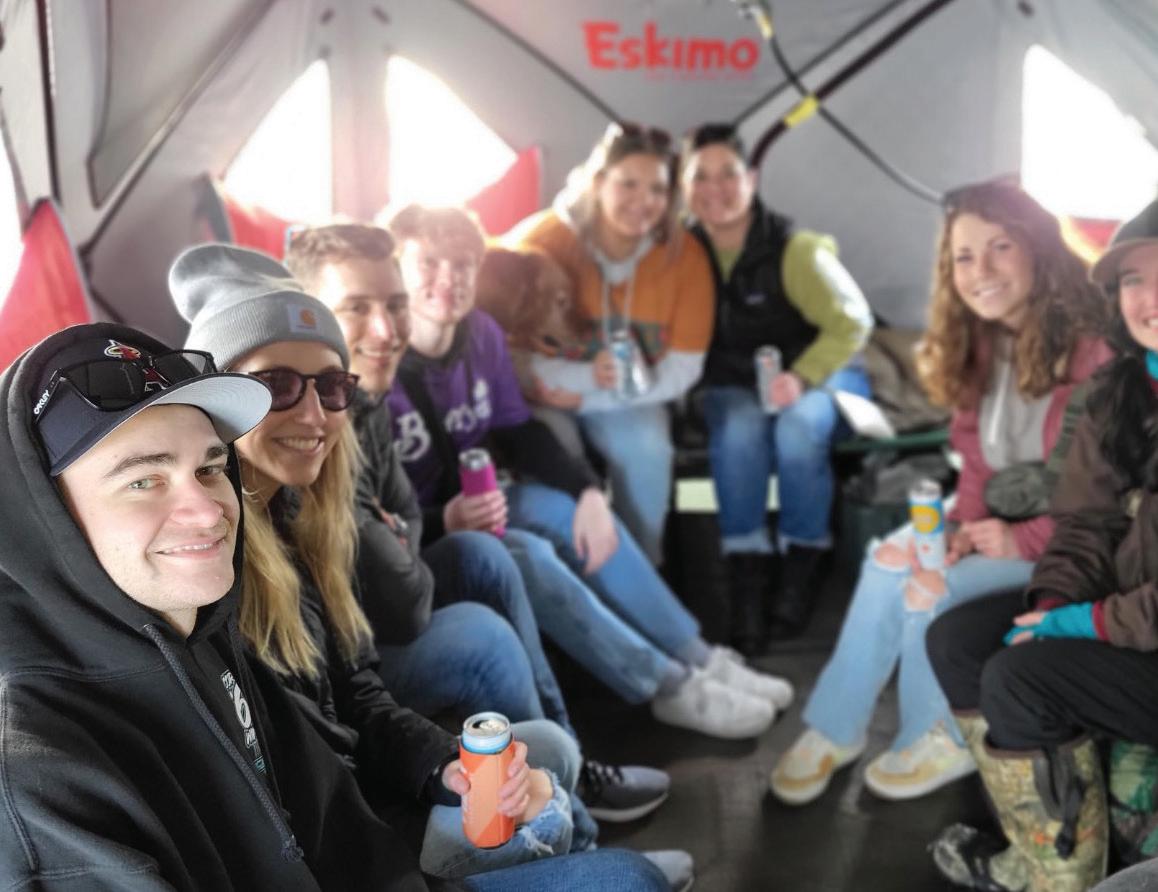


What we did was participate in the 5th annual Tip Up Pike Jam which is held on the backwaters of the Wisconsin river at Stevens Point on the grounds of The Waters Pub and Pier and run by Alex Dalnodar. Alex is a full-time musician with the band Dig Deep and loves tip up fishing and does not like electronics, kind of like yours truly. The first 99 people in line were able to get into the tournament and from 11 to 7 there were seven really good bands that played in a tent for a very cool crowd.
Friday, February 16th High 33°, Low 21°

I had an atv in a trailer behind my truck. In trucks behind me was Doug Cibukla “high school buddy” and Ross Moll high school buddy’s offspring, now a buddy. Everyone was worried about breaking through the ice. I took this seriously and decided we should use Doug’ truck, go 200-yards, drill a hole and keep exploring. We had 18-inches of good
ice, found 4.5 feet of water built a large camp, set out tip ups, Selina arrived and jeepers creepers did we have fun until the wee hours of the night.
Let me describe our neighbors that were mostly in pre 70’s campers and rebuilt pop up campers as well as many UWSP students enjoying the ice. Super cool people, that had a great attitude, and no one cared what individual won the contest for big gator. One of the kids that I had a good time with both days was UWSP freshmen Brock Kendall Berndt who hopes to be a game warden someday.
Brock was with two of his friends and these kids were very polite and after witnessing the area we were having some activity today would be on that side of us for the tournament.
Saturday, February 17th
High 42°, Low 27°
Shortly after daylight my stepson Travis Dushek shows up with his fiancée Ann Shaben and her 5-yearold son Jett. Ross Moll’s son Jordan is 7 and these kids who had never met would play for the next 10 hours on the ice without taking a single break. The area of this tournament is maybe a 300-acre backwater that is on the north end of Stevens Point and in all honesty I think God has done it a big favor and kept all the people with poor attitudes from finding it because what we did today was tend our lines, sit in lawn chairs and watch the world.

Throughout the day we would visit with our neighbors or they would visit with us. Early in the tournament that

ran from 9 to 5, Brock Bernt had a flag, and he landed a 32-inch gator which was a personal best for him. I honestly was hoping a college kid, or a real young kid would get the big fish as they are the ones that need the money (32 won last year).
At 11:00 the bands started and for me it was very tempting to watch them but our gang was onto the fish even though it was slow bite, the competitor in me said stay.
About 10 of Selina’s friends from UWSP joined our party and told us there was a lot of fun to be had in the tent and that every one of the bands was excellent. At 5:00 the fishing part of this experience ended, Brock won and we headed in to listen to some music. While we were pulling tip ups, one of Doug’s went up and he caught a 31.5 incher. We went over to the party where there was a campfire, snow sculptures, the best band that I have ever listened
to, and what I can honestly say was the coolest crowd of people I have ever witnessed.
Selina came up with a great back up idea and a happy ending was enjoyed by one and all!
Sunset
Follow along the adventures of Mark Walters, a syndicated outdoor adventure columnist who lives in Necedah, Wisconsin. He began writing his column, An Outdoorsman’s Journal, in 1989. It includes hunting, fishing, lots of canoeing and backpacking. He currently writes for around 60 newspapers. He hopes you enjoy reading about his adventures!
THIS BANNER AD Sponsorship IS





 Photo contributed by Mark Walters 7-year-old Jordan Moll (left) and his new buddy, 5-year-old Jett Shaben (right) will probably be spending a lot of time in the outdoors together.
Photo contributed by Mark Walters 7-year-old Jordan Moll (left) and his new buddy, 5-year-old Jett Shaben (right) will probably be spending a lot of time in the outdoors together.
to read more? Check out previous weeks’ columns at www.outdoorsmansjournal.com
Want
The 5th Annual “Tip Up Pike Jam”
Photo contributed by Mark Walters Alex Dalnodar is part of the band “Dig Deep” and is the man behind “Tip Up Pike Jam” and he caught this gator the week before Tip Up Pike Jam.
AVAILABLE "An Outdoorsman's Journal" is a paid syndicated column written by professional outdoorsman and Necedah native Mark Walters. In order to continue running his outdoors column, we need sponsor(s) to fill the space in print and online so we can continue to support Mark in his adventures and follow along. This space is premium placement top-of-mind awareness, perfect for both businesses that engage with the outdoors or businesses whose customers engage with the outdoors. Only $150 per week. May be divided among businesses, inquire by email. Interested? Give us a call at 608-588-6694 or an email at ads @valleysentinelnews.com Thursday, March 9, 2023 Page 12 Outdoors & Recreation
Photo contributed by Mark Walters Selina Walters and a bunch of her UWSP friends hanging out in our ice shack.









































 — Mary Lanita Schulz
— Mary Lanita Schulz

 Taylor Scott, Managing Editor
Taylor Scott, Managing Editor





















 Photo contributed by Mark Walters 7-year-old Jordan Moll (left) and his new buddy, 5-year-old Jett Shaben (right) will probably be spending a lot of time in the outdoors together.
Photo contributed by Mark Walters 7-year-old Jordan Moll (left) and his new buddy, 5-year-old Jett Shaben (right) will probably be spending a lot of time in the outdoors together.